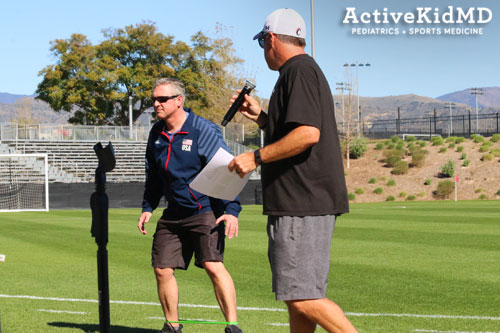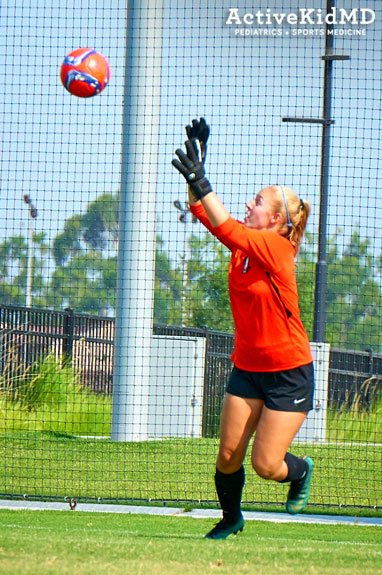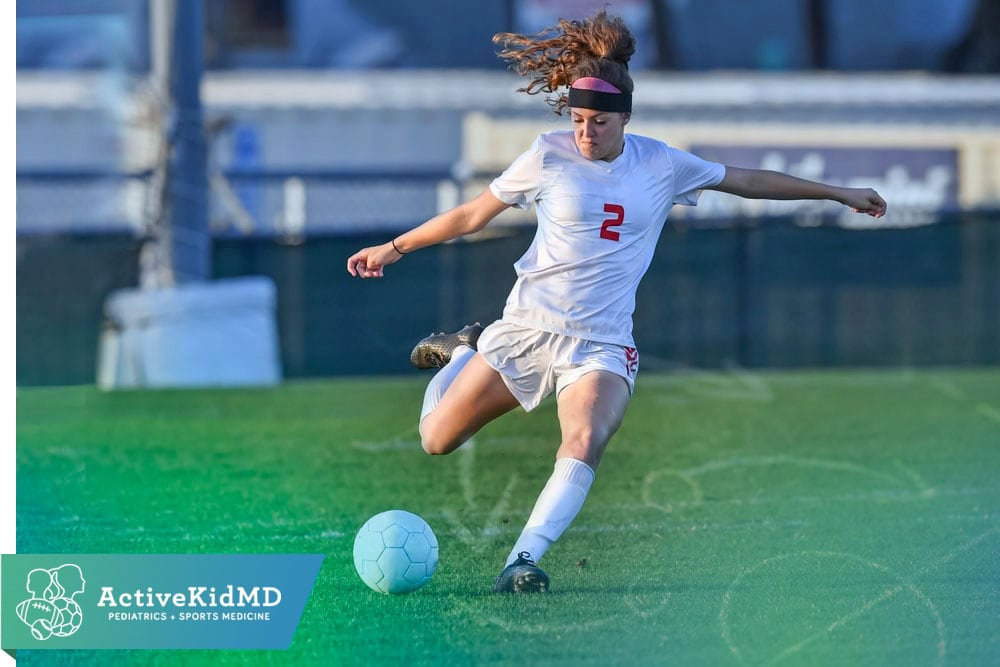Just like winning takes a full team effort, soccer safety needs players, coaches, officials and families all working together to keep kids safe. Let’s take a look at how to keep players safe before taking the field, while on the field as well as what to do if an injury should occur.
SOCCER SAFETY: BEFORE TAKING THE FIELD
First and foremost, know your athletes. Athletes with medical issues (asthma, diabetes, sting allergies) can contribute best when they have action plans developed by medical providers that list key medications and how to respond to emergencies. Parents and coaches should make sure that both action plan and medications (including inhalers and injected epinephrine for allergic reactions) are at all games/practices, can be easily found and put into use. Coaches should have medical information cards with permission for medical treatment for all players. Knowing your athletes also means learning their personalities- a player not acting as usual might be dealing with an injury or illness that requires attention.
A history of bone or joint injuries can put players at higher risk for re-injury or new injury – especially if a past injury was not fully healed or treated. Parents should make coaches aware of any bone or joint injuries their athlete may have previously sustained.

Before every practice or game, don’t forget to check out the field. Look for any rocks or holes that could cause injury or create a bad bounce. Know the closest cross streets and how to best get emergency services right to you in case of need – especially if your team is playing at a large complex with many fields.
SOCCER SAFETY: RULE ENFORCEMENT AND SAFER PLAY
If you are preparing to officiate a game, realize that less dangerous play can reduce the number and intensity of injuries. Proper rule enforcement is in the spirit of the game and can be a major factor with injury reduction. All players, coaches and spectators should encourage appropriate rule enforcement and discourage inappropriate physical play – especially when players are challenging or jumping for a ball.
SOCCER SAFETY: RESPONDING TO AN INJURY
When an injury occurs, it is best to already have a response plan in place. Know who will evaluate the injured player and who will stay with the rest. If there is a medical professional on-site, such as an athletic trainer, involve them early and give them the authority to make medical decisions to promote player safety. Move the rest of team away from an injured player. Pre-assign someone getting the first aid kit or calling family if they are not at the field. If a 911 call is needed, understand who will make the call while others can go into the parking lot to guide the medics to the field. Don’t forget to notify league officials and fill out appropriate paperwork in the event of a significant injury.
When a player goes down, there should be no rush to move an injured athlete, especially if the player doesn’t want to get up or reports neck pain. Keep those players on the field and do not move them. No one should ever fault you for dialing 911 and activating the Emergency Medical System.
Here are some guidelines for when you should remove athletes from practice or gameplay:
- Limp or limitation in use of arms/legs
- Any concern or suspicion for concussion or head injury
- Dizziness, chest pain, trouble breathing
- Change in behavior, vomiting
- Open wound/bleeding
- Swelling or limited movement of a joint
- Finger-tip bone pain
- Athlete (or parent/guardian) hesitation with return to play
SOCCER SAFETY: SAVING GOALKEEPERS FROM INJURY

CLICK HERE FOR MORE INFORMATION ON SAVING SOCCER GOALKEEPERS FROM INJURY
SOCCER SAFETY: RESPONDING TO HEAT
When the temperatures outside rise, I always recommend using Heat Index guidelines to assess conditions and determine best response. There are several free heat index smartphone apps that can be downloaded and readily consulted before practices and games.
Heat Index Under 95° F
Always offer access to water and watch athletes carefully. Offer water breaks and check the heat index every 30 minutes. Offer ice-down towels if needed.
Heat Index 95°-99° F
Always offer access to water and watch athletes carefully. Offer water breaks and check the heat index every 30 minutes. Offer ice-down towels if needed. Reduce the time outdoors and move practice inside to air conditioning if available or postpone the practice to later in the day.
Heat Index 100°-104° F
Always offer access to water and watch athletes carefully. Offer mandatory water breaks and check the heat index every 30 minutes. Offer ice-down towels if needed. If possible, remove layers from uniforms and let players change into dry clothes. Reduce the time outdoors and move practice inside or postpone the practice to later in the day.
Heat Index 105°+ F
Stop all outside activity. Stop all indoor activity if air conditioning isn’t available and the heat index indoors is 105° or greater.
100% OF HEAT ILLNESS IS PREVENTABLE!
Plan for slow, progressive increase in exercise intensity on the first hot days. Have scheduled regular breaks and ensure all athletes get access and ample time to drink cool fluids and eat healthy salted snacks.
Use lighter uniform colors for training/playing in hot and humid conditions. Allow players to change out of wet clothes as often as possible for more efficient heat transfer.
Put up tents/pop-ups to increase shade for rest breaks and tactical talk sessions.
Monitor weight – more than 1% of total body weight loss after activity means the athlete has insufficient fluid intake and a higher risk of illness from heat/dehydration. Also ask players to monitor urine color as dark brown urine is another possible sign of inadequate fluid intake and possible kidney damage. If urine is dark brown, the athlete should receive immediate medical evaluation.
RESPONSE TO POSSIBLE HEAT ILLNESS
If you suspect possible heat illness, move the athlete into shade and remove any wet clothing. Offer cool fluids, including water or sport beverages.
If the athlete is becoming less alert, immediately dial 911/activate Emergency Medical Services. Start cooling the athlete on site before emergency transport arrives by, at minimum, placing ice around neck, in armpits, in groin region or better by placing the athlete in a small tub/pool with ice water surrounding the body below the neck.
SOCCER SAFETY: CONCUSSION AND HEAD INJURIES
A concussion can be caused by direct or rotational forces to head/upper body that lead to changes in how someone acts, thinks, or behaves. There does not need to be a direct blow to the head, as a whiplash injury to the head/neck can lead to concussion symptoms.
Common soccer mechanisms include:
- Head vs. head
- Head vs. ground
- Head vs. elbow/shoulder
- Short-range direct ball vs. head
- Knee or foot to head (when goalies diving for loose ball)
An athlete does NOT need to be knocked out to have a concussion. Again, loss of consciousness is NOT required to diagnose a concussion.
Symptoms may not immediately be present after an injury to the head and neck.
Every concussion has an individualized recovery and at the time of injury, it is nearly impossible to predict exact return to play time.

Perseveration (repeating the same comment or statement over and over again)
Emotional Lability (inappropriate laughing or crying)
Athletes staying on the “periphery” (not as engaged or aggressive while avoiding eye contact)
Acting dazed or confused
Any concussion may influence the ability to read, use electronics, attend school, and influence relationships with family and friends
SOCCER SAFETY: WHEN IN DOUBT SIT THEM OUT!
Any athlete that is suspected of having a concussion or has possible concussion-like symptoms MUST be removed from any soccer activity and MAY NOT return to play on the same day.
If there are concerns about how the athlete is acting right after a head injury, do not hesitate to refer to Emergency Room or Urgent Care for initial evaluation.
Many states have specific laws requiring removal from play with any suspected concussion and not allowing return until cleared by a medical professional who deals with sport-related concussions. That return process includes both a stepwise return to learn (school) and then a stepwise return to play. Athletes should be back to regular school attendance and function before getting back to full on-field play.
Protect your player, protect your team/school/club, and protect yourself. Remove any player with concerns about a concussion and follow and support expert medical advice during the recovery process.
SOCCER SAFETY: GENERAL INJURY PREVENTION
The FIFA 11+ program and FIFA 11+ Kids are complete warm-up programs used to reduce thigh, groin, knee and ankle injuries among male and female players aged 14 years and older. The FIFA 11+ Kids is designed for players under age 14. Studies show that teams that performed the FIFA 11+ at least twice a week had 30-50% fewer injured players.
The programs are a standardized warm-up that includes running, strength, plyometric and balance work to start training sessions at least twice a week. The program takes around 20 minutes to complete. Prior to matches, only the running exercises should be performed.
For all exercises, correct performance is of great importance. Therefore, coaches should supervise the program and correct the players if necessary.
SOCCER SAFETY: ACL- ALL TOO COMMON LIGAMENT INJURIES
The Anterior Cruciate Ligament (ACL) supports knee stability and function. Most soccer injuries are non-contact due to an abnormal and risky knee positions after cutting, landing or turning direction.
Adolescent female soccer players have a 4-8 times higher risk of ACL tears than male players of same age. An ACL tear often requires surgical repair and around a one year recovery period. There is a high risk of knee arthritis 20 years after injury.
SOCCER SAFETY: ACL INJURY REDUCTION PROGRAMS
The following are suggestions for ACL injury reduction programs:
- Sportsmetrics WIPP
Requires video for purchase or trained instructor - Prevent Injury and Enhance Performance (PEP)
Free program with 15-20 minute warm-up, also can be found on YouTube - Knee Injury Prevention Program (KIPP)
Free online training for coaches, 15-minute warm-up
Studies show 60-70% reduction in ACL injuries with these programs that can readily be used as a regular warm-up. These programs may also reduce other types of knee injuries while increasing running and jumping strength.
RELATED TOPICS:
For related topics, please see our other blogs listed below. And of course, if you suspect an injury or have any concerns about your athlete’s health, give us a call.
ACL Injury: How a few minutes a week can prevent years of tears
Soccer ACL Injuries: Two Common Movements Often Lead to Tears


